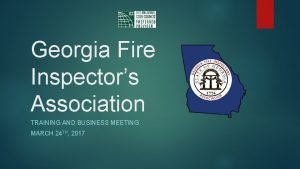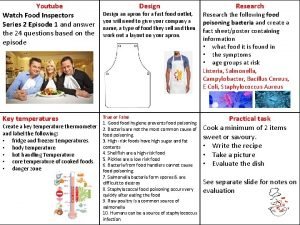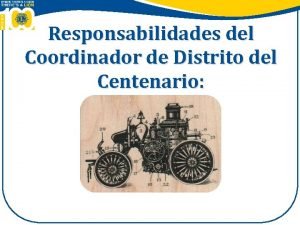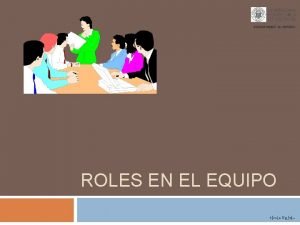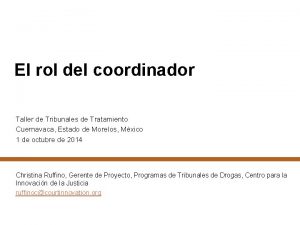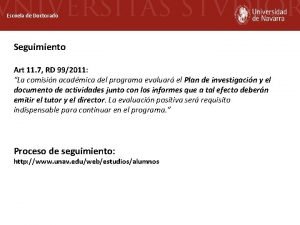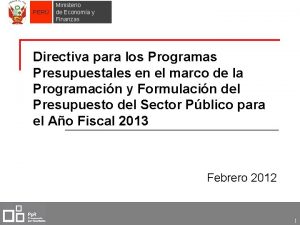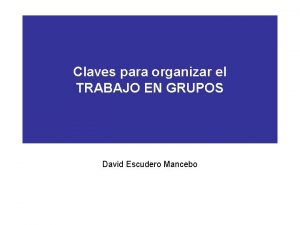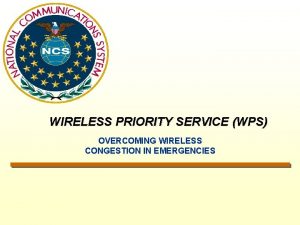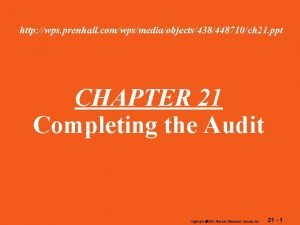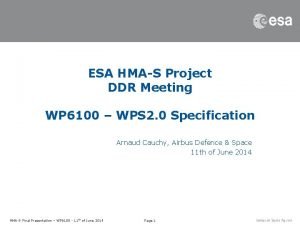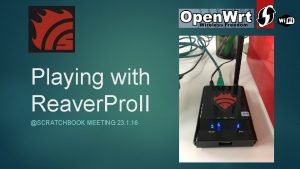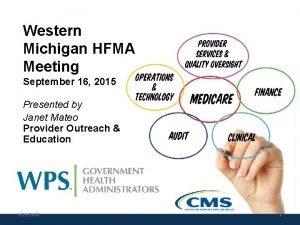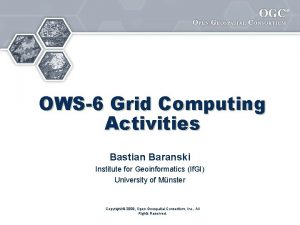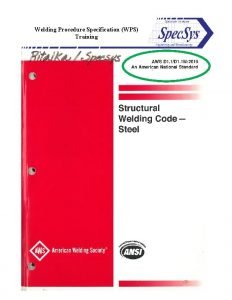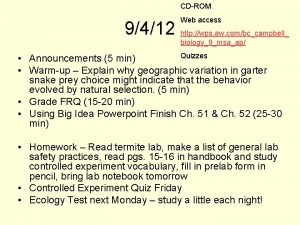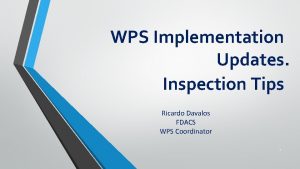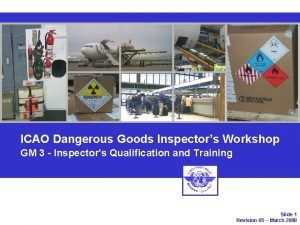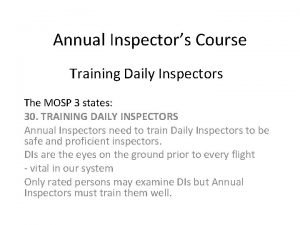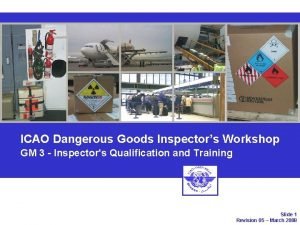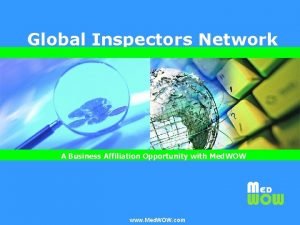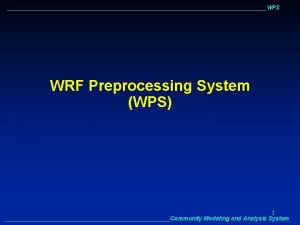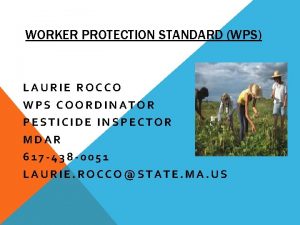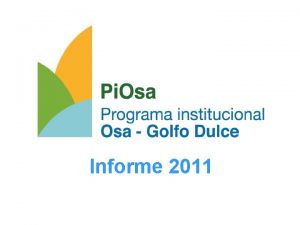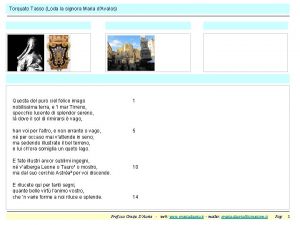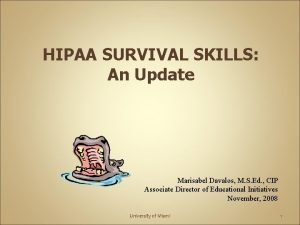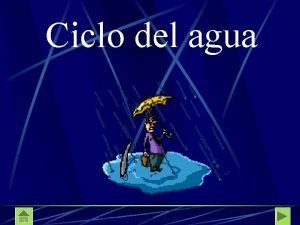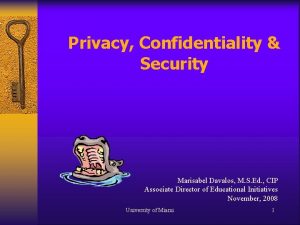WPS Review for Inspectors Ricardo Davalos WPS Coordinador



















































- Slides: 51

WPS Review for Inspectors Ricardo Davalos WPS Coordinador FDACS

The WPS requirements apply to agricultural establishments that: Use a WPS-labeled pesticide product –with a WPS reference statement in the “Agricultural Use Requirements” box; Are directly related to the production – grown, maintained or otherwise produced for commercial purposes, or for use in part or entirety in another location; Of an “agricultural plant” - includes, but is not limited to, grains, fruits and vegetables, wood fiber or timber products; flowering and foliage plants and trees; seedlings and transplants and turf grass produced for sod, hey, etc. Employ workers or handlers -- Under WPS “employing workers or handlers is defined as obtaining the services of a person in exchange for a salary or wages, including piece-rate wages either directly or through a labor contractor Non-monetary forms of compensation, such as class credit for students is not considered “employment”. Date time for prisoners is considered a compensation.

Tier 1 or Tier 2 A WPS Tier I is one that: Is conducted within 30 days after the expiration of the REI Covers all applicable WPS inspection elements Includes interviews, as applicable, with workers and handlers present at the establishment, OR provides adequate written explanation of why no workers and handlers were interviewed. A WPS Tier II inspection is one that: Is conducted after 30 days after expiration of the REI Covers all applicable WPS inspection elements Includes interviews, as applicable, with workers and handlers present at the establishment, OR provides adequate written explanation for why no workers and handlers were interviewed EPA recommends that Tier II inspections not exceeding six months from the last date of application.

Facility Type Outdoor production means production of an agricultural plant in an outside area that is not enclosed or covered in any way that would obstruct the natural air flow includes Farm, Forest and Nursery

Facility Type Enclosed space production means production of an agricultural plant indoors or in a structure or space that is covered in whole or in part by any nonporous covering and that is large enough to permit a person to enter. (old greenhouse) An Enclose space production could become Outdoor Production and VS if conditions change. (Summer VS Winter)

Facility Type Commercial pesticide handler employer means any person, other than an agricultural employer, who employs any handler to perform handler activities on an agricultural establishment. A labor contractor who does not provide pesticide application services or supervise the performance of handler activities, is not a commercial pesticide handler employer. Separate inspections at both a commercial applicator establishment and its associated agricultural establishment (customer/client) may be considered two WPS inspections

A farm labor contractor is a person, who employs workers or handlers to perform tasks on an agricultural establishment for an agricultural employer or a commercial pesticide handler employer. The agricultural employer is ultimately still responsible for WPS protections The agricultural employer may include in contracts with farm labor contractors, a requirement to comply with some aspects of WPS, Like: to conduct pesticide safety training, however, the agricultural employer is ultimately still responsible for ensuring that training is conducted and is required under WPS to maintain, onsite, the training records for FLC workers and handlers on the establishment, just as they are for workers and handlers who are hired directly. In situations where the agricultural employer has contracted with the farm labor contractor to comply with WPS protections, and those protections were not provided, the inspector should interview and obtain statements from both the agricultural employer and the farm labor contractor The inspection of a farm labor contractor should be done in conjunction with a corresponding agricultural establishment inspection

Facility Type The owner and immediate family exemption applies on establishments where at least a majority of the establishment is owned by immediate family members, i. e. , a majority of the owners are related by one of the relationships contained in the “immediate family” definition. Prior to the 2015 revisions only establishment wholly owned by immediate family members were covered. After the revisions establishments that are majority-owned by immediate family members are covered by a subset of WPS requirements.

Other Basic Inspection and Ag Establishment information: Date, name of inspector, type of inspection (unannounced/announced, neutral or for-cause). Type of agricultural establishment. Owner and manager of the establishment (name, address, and telephone). The crops grown for commercial or research purposes. Who applies pesticides (self-apply, employee, or for-hire). Who has control over or directs pesticide applications. If the establishment employs certified/licensed applicators; record credential information.

Number of Employees present: Estimate the number of workers and handlers present during the inspection Note that sometimes is important to have information about an average within the last 30 days Or when a WPS-labeled pesticide was last applied.

DISPLAY REQUIREMENTS FOR PESTICIDE SAFETY INFORMATION AND PESTICIDE APPLICATION & HAZARD INFORMATION Establishment-Specific Information (§§ 170. 403 and 170. 503) – Before any worker or handler performs any activity in a treated area or an agricultural establishment where in the last 30 days a pesticide product has been used, or an REI has been in effect, the employer must ensure workers and handlers are informed in a manner the workers and handlers can understand: location of: Pesticide safety information (poster) Pesticide application (WPS application records) Hazard information (SDS) Note that ag employer must also inform the location of decontamination supplies. The inspector should ask workers and handlers about the location of pesticide safety information, pesticide application and hazard information, and the location of decontamination supplies. (this is part of your additional interview check list)

Pesticide Safety Information Ask the agricultural employer when and where pesticide safety information is provided and how employees have access to the information. (Where is the Central Location) Verify if there is either an EPA-developed poster or pesticide information that includes the correct content. The content must include all 10 points at (§ 170. 311(a)(3)). Determine if the information includes required medical facility information (not acceptable to only post 911) : Name of medical facility Address Telephone number (make sure is right according to the location) Determine if the required information of the State pesticide regulatory agency is included. Pesticide regulatory agency/office. Telephone number. Evaluate if the information is located where employees pass or congregate and where it can be readily seen and read. Evaluate if the information is understandable, accessible and legible: Must allow free access to the information at all times during work hours. Must be legible at all times. Must be conveyed in a manner that workers and handlers can understand.

Regulatory Agency Information

Pesticide Application and Hazard Information Must be display until workers or handlers are no longer on the establishment or until at least 30 days after the end of the last applicable REI. Records must be maintain for two years after the end of the last applicable REI. The content of application information provided includes: A copy of the OSHA Safety Data Sheet (SDS) for each pesticide applied within the last 30 days or that had an REI in effect in the last 30 days. Name, EPA registration number, active ingredient and REI of each product. Crop or site treated. Location/description of the treated area(s). Date(s) and times application started and ended. Check that application display can be readily seen and read and is located where workers and handlers are likely to pass by or congregate, it is accessible at all times during normal work hours and legible. (evaluate multiple physical locations situations) The application information must be posted within 24 hours after the application and before any workers enter the treated area. Examine 2 years of records (build up from January 2018)

Pesticide Safety Training Assurance Ag Employer must ensure that each worker has received Pesticide Safety Training(PST) within the last 12 months before performs any task in a treated area where within the last 30 days a pesticide product has been used or a restricted-entry interval for such pesticide has been in effect. Also before any handler performs any handler activity involving a pesticide product, the handler employer must ensure that the handler has been trained within the last 12 months. Note: except for certified applicators, or licensed crop advisors.

Pesticide Safety Training Program Ask where the training was conducted. Must be free of distractions. Identify who trains workers and handlers and determine if they are qualified. Training must be conducted by certified applicator, person who completed EPA-approved WPS train-the-trainer program, or designated as trainer by EPA/State. (Florida Program EPA approval # TTT W/H 0003) Trainer must be present at all times and capable to answer questions. Examine the training materials used (e. g. video, handbooks, flipcharts, interactive, etc. ) and verify that it is EPA-approved. Training materials must include the new content for training after January 2, 2018. Examine materials that are not EPA-approved materials to ensure, the required 23 and 14 points are addressed. (§ 170. 502(c)(2)) Verify when and how often training is held. Must be at least within the last 12 months.

Pesticide Safety Training Program Records The inspector should examine the written records of training that should include: Worker/Handler name & signature Date of the training List of EPA-approved materials used Trainer name & qualifications Ag employer name Maintained for 2 years

Employer Information Exchange Ag Employer to CPHE Agricultural Employer Provides Information to Commercial Handler Employers (CPHE) ensure that while on his establishment they are aware of, the specific location and description of any treated areas (1/4 mile) where a REI is in effect, and the restrictions on entering those areas. Ask if the agricultural employer provides information on treated areas to commercial handler employers and how this information transfer occurs. Who communicates the information and how?

Employer information Exchange CPHE to AG Employer CPHE must provide the agricultural employer all required information before the application. Ask the CPHE if there is communication with the agricultural employer before an application, and what information is provided. CPHE must provide specific location and description of area(s) to be treated with pesticides including. Date of application, and start and estimated end times. Product name, EPA registration number, and active ingredient. Labeled REI. Whether posted or oral notification, or both are required by the label Note: Ag employer still responsible to keep records for two years

Emergency assistance If there is reason to believe that a worker has been exposed to pesticides or shows symptoms of poisoning within 72 hours after a day’s work, the agricultural employer must provide emergency assistance. Ask the worker(s) about their employer’s policy in case of a pesticide exposure incident. Ask who is contacted in an emergency. Inquire who provides transportation to an emergency medical facility if needed. Ask if the worker knows where the nearest emergency medical Ask if he/she is aware of any pesticide poisonings at the establishment. (If so, record the details and follow-up with the agricultural employer) Ask employer if SDS was provided to medical personnel

Decontamination Supplies for Workers Agricultural employer must provide decontamination supplies. Must include: Soap (no gels or wet towelettes) Water (1 gallon per worker), Towels. Ask if decontamination supplies are provided all the time, or just sometimes. Decontamination supplies are only required for 7 days post REI of 4 hours or less; For 30 days post REI greater than 4 hours. Supplies are accessible and must be within ¼ mile or nearest vehicular access.

Decontamination Supplies for Handlers Ask the handler where are the routine decontamination supplies. Decontamination supplies must include water (3 Gallons per Handler), soap, towels, and clean change of clothing such as coveralls are located. They must be located: Within ¼ mile or at the nearest vehicular access. At all mixing sites. Outside the treated area or areas under an REI unless the supplies are contained within a pesticide protected closed container. For pilots, the decontamination supplies must be in the aircraft or at the aircraft loading site. The routine decontamination supplies are available at the start of each work period.

Decontamination Supplies for Handlers using eye protection At mix/load site for pesticides requiring protective eyewear or with closed system operating under pressure, at least one eye-flush system must be immediately available. The eye-flush system must be capable of delivering gently running water at a rate of at least 0. 4 gallons per minute for 15 minutes or be 6 or more gallons of water in containers suitable for providing a gentle eye-flush for about 15 minutes. Test eye-flush systems the flow and quality (odorless, colorless, appropriate temperature). Ensure the eye-flush system is manageable for one person to operate (e. g. , holding a six gallon container above your head or having to empty six 1 gallon containers, would not be a manageable system). Check to see if 1 pint of water is immediately available (i. e. , within a few seconds/within a few steps) to applicators using pesticides requiring protective eyewear.

RESTRICTIONS DURING APPLICATIONS Are workers prohibited in treated areas during application and until REI(s) have expired and all treated area warning signs have been removed or covered?

Are workers and other persons prohibited in treated areas plus the additional AEZ for outdoor production applications? An agricultural employer must not allow or direct any worker or other person to enter or remain in the AEZ within the boundary of the establishment. AEZ is 100 feet if applied aerially, as air blast, as a spray of very fine or fine spray quality or as a fumigant, smoke, mist, or fog. AEZ is 25 if applied from a height of 12 inches and spray quality of medium or larger. . Note: Not exceptions when AEZ falls in their own property For AEZ outside of property lines (Suspend and evaluated)

Are workers and other persons prohibited in treated areas plus the additional AEZ for outdoor production applications? Ask the employer what types of equipment are used Ask the employer how he determines size of the AEZ for each application Ask the employer how the spray quality of the application is determined. For example: What nozzle was used What pressure was used Is a nozzle size and pressure required on the label Ask the employer how he or she estimates the size of the AEZ. How large is 100’ or 25’? How the agricultural employer keeps workers or other people out of the AEZ within the establishment.

Are workers prohibited in enclosed space production During any enclosed space application, an agricultural employer must not allow any worker or other person to enter or remain in the area specified in column B of § 170. 405(b)(4) until the time specified in column C has expired. See Appendix X for Table on Entry Restrictions During Enclosed Space Production Pesticide Applications. Ask how the agricultural employer keeps workers and other people out of the enclosed space during pesticide applications. Ask how the agricultural employer determines when the ventilation criteria have been met (i. e. , is inhalation exposure level determined, are air exchanges measured, or are mechanical or passive ventilation systems used).

Exceptions for Entry by Workers during the REI An agricultural employer may direct workers to enter treated areas under an REI to perform certain activities Are workers ever directed to enter treated areas under an REI? What justification was there to allow the early entry? Depending on the response, the inspector should ask if the conditions were met as appropriate.

Exceptions for Entry by Workers during the REI Worker No Contact – early entry is allowed if: Workers will have no contact with any pesticide treated areas (soil, water, plants), even with PPE; and Entry is not allowed until labeled inhalation exposure is met or ventilation criteria at § 170. 405(b)(3) is met. Worker Short-term Activities – early entry is allowed if: No hand labor is performed; The time in treated area does not exceed 1 hour in every 24 hours; Entry is not allowed until 4 hours after application; and Entry is not allowed until labeled inhalation exposure is met or ventilation criteria at § 170. 405(b)(3) are met.

Exceptions for Entry by Workers during the REI (Agricultural Emergency) – Entry under the REI by a worker is allowed, only when: The agricultural employer could not have anticipated the circumstances for the emergency and has no control but requires entry under REI to prevent/mitigate substantial economic loss. The Department of Agriculture, declared the agricultural emergency If early entry is allowed under an agricultural emergency, the agricultural employer must meet the follow requirements: Entry is not allowed until 4 hours after application Entry not allowed until labeled inhalation exposure is met or ventilation criteria at § 170. 405(b)(3) is met.

Exceptions for Entry by Workers during the REI (Labels with double notification) If the label requires double notification, a worker can only work in treated area for maximum of 4 hours in any 24 hours.

Exceptions for Entry by Workers during the REI (Limited Contact and Irrigation) Workers may enter treated areas under the REI for limited contact or irrigation activities, provided that: Without this exception, there would be substantial economic loss; There are no alternative tasks to prevent the loss. The need for the work was not anticipated (except for irrigation); No hand labor was performed; Worker will have no contact with any pesticide treated areas (soil, water, plants), other than minimal to feet, lower legs, hands, and forearms; The time in treated area does not exceed 8 hours in a 24 hour period; Entry is not allowed until 4 hours after application; Entry not allowed until labeled inhalation exposure is met or ventilation criteria at § 170. 405(b)(3) are met; The pesticide’s labeling DOES NOT require double notification.

Protection of Workers in a Treated Area during the REI Where workers directed to enter treated areas during the REI. Is any employed early entry workers are under 18 years old. How was verified (e. g. , driver's license, birth certificate, etc. ) Ask if the agricultural employer provides the following required information before the early entry: Location of the early entry area for work activities. Pesticides applied. Dates and times that REI begins and ends. The specific early entry exception taken, and tasks to be performed. If contact with treated surfaces is permitted. Length of time the worker is allowed to be in the treated area. Early entry PPE required. Specific location on the establishment of the central posting and decontamination supplies.

Protection of Workers in a Treated Area during the REI Workers read or are informed of labeling requirements The appropriate early entry PPE is provided to the workers The PPE is used according to manufacturer’s directions. The early entry PPE is maintained properly. Measures to prevent heat stress are implemented, and the workers are instructed in the prevention, recognition, and first aid treatment for heat stress. Workers on instructed on the proper use, removal, cleaning, maintenance, and disposal of the early entry PPE. Workers do not take their pesticide contaminated PPE home. Decontamination supplies are provided (Water 3 gallons and eye flush include when need)

Notice of applications (Workers) Outdoor Examine the pesticide label for the required type of notification Who notifies workers and handlers of applications. When the employer gives oral notification and when posted notification Verify outdoor applications posting interval requirements. Note: No notification is needed if from the application start to the expiration of the REI, no worker will enter or travel within ¼ mile of the treated area. ) Verify if product requires double notification, then employer must post and orally notify workers. Verify if product REI is 48 hours or less, then employer may post or orally notify workers. Verify if product REI more than 48 hours, then employer must post to notify workers.

Notice of applications (Workers) Enclose space Ask when the employer gives oral notification and when posted notification Enclosed space applications posting requirements: Verify if product requires double notification, then employer must post and orally notify workers. Verify if product REI is 4 hours or less, then the employer may post or orally notify workers. Verify if product REI is greater than 4 hours, then employer must post to notify workers. Note: No notification is needed if, from the application start to the expiration of the REI, no worker will enter any part of the enclosed space

Warning Signs Establish that the warning sign is of the required size: Standard Sign is 14 X 16 inches; letters 1 inch height: Outdoor posting at all visible points of entry to treated area Indoor posting at all visible points of entry to the structure/space, or at corners of treated area, or at entry points to the treated subsection within a larger space. Medium-sized Sign Letters 7/8 inches height; red circle 3 inches diameter: Post 50 feet apart around the treated area, and at all locations as specified for the standard outdoor/indoor sign above. Smallest Sign Letters 7/16 inches height; red circle 1 ½ inches diameter: Post minimum 25 feet apart around treated area, and at all locations as specified for the standard outdoor/indoor sign above.

Warning Signs Warning signs on-site meet the WPS required content (stern face and raised hand in red circle, DANGER PESTICIDES (PELIGRO PESTICIDAS), KEEP OUT (NO ENTRE)); Spanish language may be replaced with another language read by most workers. Verify that the warning signs are visible and legible while posted. Verify that warning signs are posted before, but no more than 24 hours before the application. Verify that warning signs are removed or covered within 3 days after the end of the application or any REI expires, whichever is later. Exception: Signs may remain posted more than 3 days after the REI as long as any workers that may come within ¼ mile of the treated area are instructed not to enter the treated area while signs are posted. Ask how the employer assures that workers do not enter treated areas while the signs are posted.

Oral Warnings Ask when and how oral warnings are given. Determine if oral warnings are provided before the application begins. Determine if warnings are given at the start of the worker’s work period if workers arrive during the application or before the end of the REI. Inquire how oral warnings are communicated to non-English speaking workers; Assess if the oral warnings include: Location and description of the treated areas(s). Dates and times of restricted entry. Instructions not to enter the treated area(s) or application exclusion zone.

Applications restrictions and monitoring Do both the handler employer and the handler ensure that no pesticide is applied (either directly or through drift) so as to contact anyone other than trained and PPE-equipped handlers involved in the application? The applicator is responsible to carries this provision as well and he could received penalties as well

Monitoring Are handlers monitored visually or by voice every 2 hours when handling Skull & Crossbones pesticides? Does the handler have continuous visual or voice contact with another trained and PPE-equipped handler stationed immediately outside of the enclosed space when handling a fumigant in enclosed space production? Does the handler performing the application immediately suspend application if anyone, other than an appropriately trained and equipped handler is in the application exclusion zone? (Handler could be fine for non compliance)

SPECIFIC INSTRUCTIONS FOR HANDLERS Does the handler employer ensure that handlers read the label or are informed about the label requirements? Does the handler have access to the product labeling during handling activities? Is the handler aware of requirements for any entry restrictions, application exclusion zones and restricted-entry intervals as that may apply based on the handler's activities? Does the handler employer ensure that the handler has been informed or is aware of the specific location of pesticide safety information, pesticide application and hazard information, (central Location) and decontamination supplies?

Safe Operation of Equipment Pesticide handler employers must ensure that before any handler uses any equipment for mixing, loading, transferring, or applying pesticides, the handler is instructed in the safe operation of such equipment. The inspector should ask the handler employer who trains the handlers on the safe use of the equipment. Pesticide handler employers must ensure that before each day of use, equipment used for mixing, loading, transferring, or applying pesticides is inspected for leaks, clogging, and worn or damaged parts, and any damaged equipment is repaired or replaced. Who checks the equipment, how often, and if there is a process to ensure pesticide equipment integrity. Are mechanics training as handlers?

PPE Equipment Provided by Handler Employer The handler employer must provide to the handler the label required PPE, in clean and operating condition. Shirts, pants, shoes, and socks are not considered PPE, but may still be required by the labeling Examine the PPE in storage and compare this against some previously used product labels to verify that the PPE is available and in clean/operating condition.

PPE Verify that any labeled PPE requirements such as “chemical-resistant or waterproof equipment, chemical-resistant suit, coveralls, chemical-resistant apron, or chemical-resistant headgear” match the PPE on-site. Examine the gloves on-site and verify they include any specified on product labels (e. g. , barrier laminate gloves) Examine that all PPE previously used are clean and in a usable condition. Examine the footwear on site to ensure that it matches any label requirements for “chemical-resistance”. If labels of previously used pesticides require protective eyewear, verify that such is on-site.

PPE (Respirators) Examine the respirators on-site to determine if appropriate according to label requirements. (Note some older product labels may refer to outdated respirators e. g. , “dust/mist” respirators. ) Examine the handler employer’s respirator fit testing, medical evaluation and training records Handlers must be fit tested and medically evaluated before they use any respirator) for handlers to verify: The handlers have had a medical evaluation by a licensed physician or licensed health care professional The handlers have been trained in the use of the respirator on-site in the past 12 months. The handlers have been fit tested on the exact make, model, style and size of respirators within the past 12 months. Verify that these respirator records have been maintained for 2 years. Note: Some medical clearances extend for more than 2 years. The employer will need to retain the records of medical clearance for more than 2 years

Closed System Inquire if the handler uses closed systems for any mixing/loading of pesticides. PPE exceptions only apply where the handler employer meets the conditions below: The handler mixing products in the closed system is completely contained Verify if the closed system operating instructions are available. Must be at mix/load site. Instructions must be clearly legible and include procedures for use, Safe removal of probe, Maintenance, Cleaning, Repair, know restrictions/limits Incompatible pesticides or containers not suitable Limits on measuring, How to deal with partially-filled containers.

Closed System When using a closed system that meets all the requirements there are some exceptions to labeling-specified PPE that are permitted: Handlers using a closed system to mix/load “DANGER” or “WARNING” pesticides may substitute a long-sleeved shirt, long pants, shoes and socks, chemical— resistant apron, protective eyewear, and protective gloves for any labeled PPE. Handlers using a closed system to mix/load pesticides with signal word other than” DANGER” or “WARNING” may substitute a long-sleeved shirt, long pants, shoes and socks, and protective eyewear, and for any labeled PPE. Ask what PPE is used when using water soluble packing that is compromised. If compromised, it is no longer consider a closed system, and then full labeled PPE must be worn. Protective eyewear must be worn when using closed systems under pressure. Ask if/when the handler was trained in the use of the closed system. Ask who cleans and maintains the closed system. Check that all labeled PPE is available immediately to a handler in an emergency

Family Exemptions Immediate family is limited to the spouse, parents, stepparents, foster parents, fatherin-law, mother-in-law, children, stepchildren, foster children, sons-in-law, daughters-inlaw, grandparents, grandchildren, brothers, sisters, brothers-in-law, sisters-in-law, aunts, uncles, nieces, nephews, and first cousins. ‘‘First cousin’’ means the child of a parent’s sibling, i. e. , the child of an aunt or uncle. [170. 305]

Family Establishment Exemptions Owner of an agricultural establishment exempt from providing most WPS protections to himself and members of his immediately family who are performing tasks related to production of agricultural plants on their own establishment, including exemption from minimum age requirements for handler and early-entry workers. The owner of the agricultural establishment must provide WPS protections to all workers, handlers and other persons who are not members of his immediate family. The owner and his family members are not exempt from wear the PPE listed on the label and from fit testing and medical evaluation if respiratory protection is used.

Questions Ricardo Davalos 850 -528 -5402 WPS@freshfromflorida. com
 Gafsed
Gafsed Animal quarantine department
Animal quarantine department Food inspectors series 2 episode 2
Food inspectors series 2 episode 2 Worcester ma building department
Worcester ma building department Iso casco
Iso casco Coordinador de distrito
Coordinador de distrito Qué rol
Qué rol El coordinador
El coordinador Coordinador de tribunal
Coordinador de tribunal Plan de trabajo coordinador deportivo
Plan de trabajo coordinador deportivo El coordinador
El coordinador El coordinador
El coordinador El coordinador
El coordinador Wireless priority service wps
Wireless priority service wps Wps.prenhall.com
Wps.prenhall.com Ddr meeting
Ddr meeting Reaver pro
Reaver pro Wps csnap
Wps csnap Wps
Wps Wps teams
Wps teams Welding technique
Welding technique Wps fedora
Wps fedora Wps.aw.com
Wps.aw.com Smärtskolan kunskap för livet
Smärtskolan kunskap för livet Luftstrupen för medicinare
Luftstrupen för medicinare Frgar
Frgar Teckenspråk minoritetsspråk argument
Teckenspråk minoritetsspråk argument Delegerande ledarstil
Delegerande ledarstil Humanitr
Humanitr Multiplikation uppställning
Multiplikation uppställning Toppslätskivling dos
Toppslätskivling dos Returpilarna
Returpilarna Borra hål för knoppar
Borra hål för knoppar Redogör för vad psykologi är
Redogör för vad psykologi är Geometri för barn
Geometri för barn Bris för vuxna
Bris för vuxna Bra mat för unga idrottare
Bra mat för unga idrottare Ledarskapsteorier
Ledarskapsteorier Offentlig förvaltning
Offentlig förvaltning Datorkunskap för nybörjare
Datorkunskap för nybörjare Antikt plagg i rom
Antikt plagg i rom Fspos vägledning för kontinuitetshantering
Fspos vägledning för kontinuitetshantering Rita perspektiv
Rita perspektiv Ministerstyre för och nackdelar
Ministerstyre för och nackdelar Plats för toran ark
Plats för toran ark Bästa kameran för astrofoto
Bästa kameran för astrofoto Tillitsbaserad ledning
Tillitsbaserad ledning Nyckelkompetenser för livslångt lärande
Nyckelkompetenser för livslångt lärande Bunden eller fri form
Bunden eller fri form Tidbok
Tidbok Mästar lärling modellen
Mästar lärling modellen Varför kallas perioden 1918-1939 för mellankrigstiden?
Varför kallas perioden 1918-1939 för mellankrigstiden?
